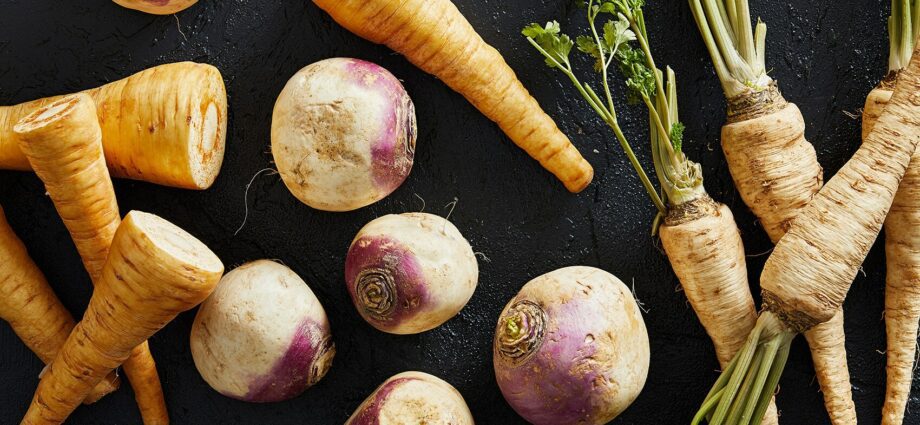Contents
Turnips, rutabagas, and other forgotten vegetables to return to your diet
We suggest diversifying your diet with vegetables high in vitamins and minerals, which our grandmothers loved so much.
How often did your grandmothers mention strange vegetables whose names were not found anywhere else? Probably, almost everyone has heard about the famous rutabaga, but not everyone knows what it is. And she, by the way, has a whole range of important vitamins and minerals, like many other foods forgotten since Soviet times. Together with the experts of the BILLA supermarket chain, we propose to get acquainted with 5 healthy vegetables that the older generation told us about, and learn about their more popular counterparts. Since spring is the best time for culinary experiments, especially if they are able to strengthen the immune system during the dangerous off-season.
Jerusalem artichoke
An earthen pear, or Jerusalem artichoke, is an extremely unpretentious vegetable to grow, the fresh fruits of which are harvested throughout the year. It contains not only a lot of iron, magnesium and zinc, but also phosphorus, calcium, as well as vitamins of group B, C, E and A. It tastes like the core of a cabbage head. Jerusalem artichoke is added to drinks, sweet, first and second courses. Eating it regularly
has a positive effect on the digestive system, reducing bloating and preventing inflammation;
lowers blood sugar levels;
improves the general condition of diabetic patients.
Finding this vegetable in its pure form is not an easy task, but you can find natural Jerusalem artichoke syrup in stores.
Turneps
Turnip, which was very popular several decades ago, outwardly resembles a familiar turnip, painted cream inside. The surface of the fruit can be purple, pink, or light green. This vegetable contains a lot of vitamin C, and once it completely replaced potatoes and was the most common dish for lunch or dinner. Turnip tastes like a radish, and in cooking it is added to salads, soups or stews. By the way, turnip tops are also suitable for human consumption, because they contain a whole variety of microelements and vitamins of groups B and C. The vegetables closest to turnips today are radishes or turnips. Prepare salads, main courses or appetizers from them, combining bright taste with benefit.
rutabaga
The famous rutabaga also looks like a turnip, but it can be stored for much longer, up to several years. The first and second courses are prepared from the rutabaga, peeling it from the thin peel, after which it is boiled or stewed along with other ingredients. It contains potassium, calcium and even iodine salts. This vegetable contains mustard oil, which has antiseptic properties that kill harmful microflora. Even people with diabetes mellitus can eat rutabagas, because its carbohydrates are represented by almost only fructose. Rutabaga dishes
improve digestion, enhancing intestinal motility;
help with edema and atherosclerosis.
You can hardly find this vegetable in a regular grocery store, but radish, which is almost identical in taste and useful properties, can be found on supermarket shelves without any problems.
Parsnip
Parsnips can only be compared with carrots or parsley root. The oblong fruit, which has a white or grayish color, contains a whole complex of vitamins of group B and C, as well as protein, carotene, potassium and fiber. Its caloric content is just over 50 kcal per 100 g of product, which makes it suitable for a dietary menu. Parsnips are used in salads, soups, vegetable stews, mashed potatoes and any other main course. In Soviet times, parsnips were also added to foods during the preservation process, as they provide excellent protection against acidification of vegetables. Carrots are analogous to parsnips, which will be an excellent addition to your lunch or dinner, filling the body with useful vitamins and minerals.
Celery root
Celery is one of the favorite foods of all those who are losing weight or who follow a healthy diet. And its root, by the way, was also eaten, lowering the level of cholesterol in the blood and preventing the occurrence of gastrointestinal diseases. It contains a lot of potassium and magnesium, as well as calcium and sodium, which together have a beneficial effect on the state of the body, strengthening blood vessels and the heart. The product also has a very low calorie content, so it is used for preparing PP dishes and dietary salads, having previously peeled from tough skins. Nowadays, celery root can be found in seasonings, but fresh stalks can be found in almost any store. The main thing is to choose the juicy ones.










